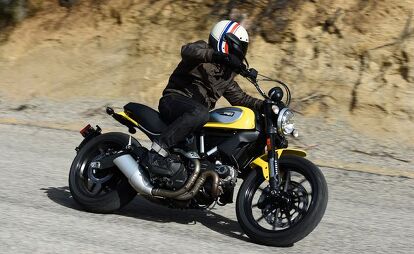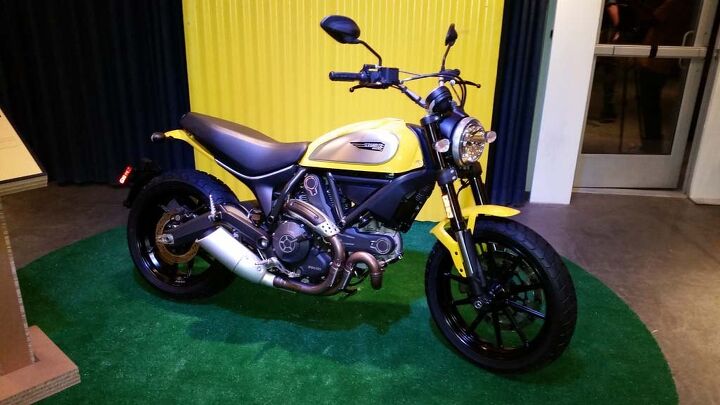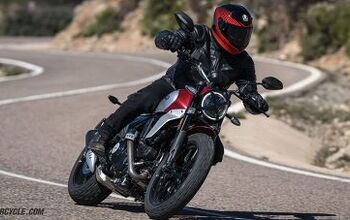2015 Ducati Scrambler First Ride Review

Standing in “The Land of Joy,” a makeshift beach party Ducati set up inside the Ace Hotel in Palm Springs, California, to serve as its central command post for the 2015 Scrambler launch (the first time a new Ducati model has been introduced Stateside), it was quickly apparent this wouldn’t be like any prior Ducati launch.
2015 Ducati Scrambler
| Engine | 17.5/20 |
| Suspension/Handling | 12.0/15 |
| Transmission/Clutch | 8.0/10 |
| Brakes | 8.5/10 |
| Instruments/Controls | 4.0/5 |
| Ergonomics/Comfort | 9.5/10 |
| Appearance/Quality | 8.0/10 |
| Desirability | 9.0/10 |
| Value | 7.0/10 |
| Overall Score | 83.5/100 |
Instead of racetracks, engine schematics and suspension diagrams, videos of international launch parties, camping trips and surf adventures were playing on the screen. In this age of wearing skinny jeans, riding skateboards and drinking IPAs, Ducati is hoping the Scrambler will be an icon for an entirely new generation of riders less concerned about performance and more interested in individuality, personalization and fun.
Discuss this at our Ducati Scrambler Forum.
In fact, during the “technical” presentation, its Monster 796-sourced, 803cc, two-valve, air-cooled V-Twin was only mentioned in passing. The fact the Desmodue engine utilizes an 11-degree valve overlap for optimal low and mid-range torque wasn’t muttered very loudly either. The single 330mm front brake disc and accompanying radial-mount four-piston Brembo caliper were given a little attention, considering its sporting roots, but that was mainly it.
Ducati Scrambler Retrospective
Originally introduced in 1962, the Scrambler lasted for 13 years, until its end in 1975. But instead of producing a retro-themed motorcycle, Ducati’s inspiration was to bring back the Scrambler, after 40 years, as if the company had never stopped making them. The result is what you see here, heavily inspired by, but not a throwback to, the original Scrambler. However, in this day and age of personalization and customization, Ducati didn’t bring just one Scrambler to market, but four: the Icon, Urban Enduro, Full Throttle and Classic.
One Bike, Infinite Possibilities
All four Scramblers share the same engine, ABS brakes, Kayaba suspension (only adjustable for rear preload) and Pirelli MT 60 RS dual-sportish tires, specially designed for the Scrambler and its 18-inch front wheel. The overall shape of the bike follows the form of the original, with the teardrop design of the 3.5-gallon steel fuel tank with interchangeable inserts the central focal point. Ducati only brought Icon models to test, stating the other three weren’t ready to ride by the time of the intro. No matter, since the Icon and its yellow (or red) fuel tank, cast 10-spoke wheels, high tapered bars and black seat is the basis for the others.
2015 Ducati Scrambler Unveiled! + Video
As the name might imply, the Urban Enduro is suited to tackle the urban jungle and is best suited for the occasional fire road excursion. Its matte green color separates it from the rest, and it also receives wire wheels, engine sump guard, high front mudguard, headlight grill, handlebar cross brace, fork protectors, and a brown seat with a dedicated ribbed stitching pattern.
Next, the Full Throttle draws its inspiration from dirt-track racing, where its low, tapered handlebars place the rider in a more aggressive position. It also gets a short front fender, black paint scheme with yellow accents, and, as it’s the most performance oriented of the Scrambler variants, is fitted with a Termignoni slip-on.
Drawing the closest relationship with the past, the Scrambler Classic expands upon the retro-modern theme of the Icon. With an “Orange Sunshine” paint scheme, the Classic gets the same wire wheels as the Urban Enduro, an extended rear fender, a dedicated brown seat with “lozenge-type” stitching pattern and a fuel tank with a black center stripe, just like the Scrambler from the ’70s.
Because personalization is such an important aspect of the Scrambler, all the components from the four variants are all interchangeable with each other. Not only that, Ducati is working on a long list of parts and accessories ranging from fuel tank inserts to waterproof luggage, to truly make the Scrambler your own. The Scrambler experience doesn’t stop there; a whole line of Scrambler apparel is in the works, too. From T-shirts and hoodies to armored riding jackets that look like fashion wear, Ducati is trying hard to emphasize the Scrambler is more than a motorcycle, but a lifestyle.
A Millennial’s Perspective
Of course, a lifestyle built around a motorcycle only works if the machine provides a level of emotional pleasure. And if pure riding enjoyment is what Ducati is going for, then it might be on to something with the Scrambler.
The mechanical simplicity of the Scrambler makes it relatable to a wider audience, including those who will inevitably want to customize it. With no power modes, traction control, or a radiator and its associated hardware, the Scrambler is an easy bike to understand. Couple that with a claimed wet weight of 410 lbs, 75 hp and 50 lb-ft. of torque, and the bike is also quite sporty. Our ride route from Palm Springs to Idyllwild and back presented a great way to showcase these attributes. Unfortunately, because of a recent rain storm in the area, the fire roads Ducati had planned for us were washed out and deemed unsuitable for the bike.
As for the riding impressions, let’s start with the good news: on paper a two-valve, air-cooled Twin might not sound very exciting, but on the road, the 803cc V-Twin is a real gem. It’s abundant low-end torque is just the ticket for around-town riding or playing in the twisties en route to getting lost trying to find a campground.
Reaching the ground, even for my 30-inch inseam, wasn’t a problem thanks to a 31.1-inch seat height, a narrow seat/tank juncture and the overall slim nature of the motorcycle. However, if you’re still nervous about touching down, a low, 30.3-inch seat is available as an accessory.
The high bars, combined with pegs mounted directly underneath the rider means the rider triangle is the very definition of neutral. Having those wide bars makes leveraging the Scrambler an easy task, whether its through the twisties, a fire road, or filtering through congested city streets. Pirelli’s MT 60 RS tires, with their knobby-like tread blocks, are surprisingly competent on the street. The cable-actuated clutch is light-ish, and a slipper clutch is a welcome addition on an $8595 motorcycle ($8495 for the red, $9995 for the other models).
Despite only having one front brake disc, the performance from the 330mm rotor and Brembo four-pot radially mounted caliper is impressive. Really, having twin front discs would have been overkill, plus the single setup leaves the other side of the wheel unobstructed for the world to see. A 245mm rear disc is mated to a single-piston caliper, and with the ABS switched off, takes considerable pressure to lock up.
Strangely, there were areas where the Scrambler didn’t seem as polished as we’ve come to expect from Ducati. Most notably, one rider in our group had a fuel line come loose underneath the tank, spewing gas onto those behind him, of which I was one. Aside from that freak occurrence, many of the journos in attendance, myself included, complained of abrupt power application within the first few degrees of throttle twist. However, after that, getting on the gas was met with enjoyable forward thrust.
It should be noted that the pre-production test bikes ridden at the intro were all built at Ducati’s main plant in Bologna, though production models slated to come to the States will be manufactured in Ducati’s Thailand facility.
Clicking through the six gears seemed a bit notchy as well, with some people reporting hitting several false neutrals. It only happened once for me, but considering the bikes we rode only had 120 miles on the clock, it’s reasonable to expect the trans to feel better after more miles.
Those looking to do more off-road riding with the Scrambler might be pleased to learn ABS can be switched off, but there is no provision to turn only the rear off once the blacktop turns brown.
The seat was slightly firm for my taste, though, like the transmission, I suspect that will get better after a few miles as well. Speaking of firm, considering the suspension is only adjustable for rear preload, I was surprised by its level of stiffness. Bikes with limited suspension adjustment are usually set on the soft side for a comfortable ride, and while the Scrambler certainly wasn’t harsh, I wouldn’t mind slightly softer springs at each end and rear rebound slowed down a smidge.
The Bigger Picture
All in all, those are relatively minor quibbles especially considering the bike is aimed at an entirely different demographic than those who gripe about a click or two more rebound. The overriding question here is simple: Is the Ducati Scrambler fun to ride? It absolutely is. The Scrambler distills the enjoyment of riding into its most basic and elemental forms – a refreshing take in this modern age of increasingly advanced motorcycles.
While at the launch, I spoke with some and overheard others, all with considerably more tattoos than me, who were genuinely excited about the bike and had already decided they would be getting one. When asked why, reasons varied from “It can do everything my Triumph Scrambler can do, only better,” to, “I can’t wait to get one in my shop and really make it my own.”
If the response the Scrambler is getting on social media is any indication of its sales success, then Ducati will be in for a nice 2015. But what about that other Scrambler? You know, the one from Triumph, the de facto standard bearer in this category. Has it now become obsolete? Considering both bikes share the same name, naturally a comparison test is in order. Stay tuned, as we’ll be bringing it to you one as soon as we can.

Troy's been riding motorcycles and writing about them since 2006, getting his start at Rider Magazine. From there, he moved to Sport Rider Magazine before finally landing at Motorcycle.com in 2011. A lifelong gearhead who didn't fully immerse himself in motorcycles until his teenage years, Troy's interests have always been in technology, performance, and going fast. Naturally, racing was the perfect avenue to combine all three. Troy has been racing nearly as long as he's been riding and has competed at the AMA national level. He's also won multiple club races throughout the country, culminating in a Utah Sport Bike Association championship in 2011. He has been invited as a guest instructor for the Yamaha Champions Riding School, and when he's not out riding, he's either wrenching on bikes or watching MotoGP.
More by Troy Siahaan


































































Comments
Join the conversation
9 GRAND FOR a bike made in Thailand?? No thanks.
Looks nice though.
To all Global 'Scrambler' afectados,
Ari Henning was reviewing a 'Scrambler' and found it's Hang Up literally - that Low Slung Exhaust!
Suggest Bologna devise then replace this component with a 'Bash Plate' Exhaust.
It featuring separate Emission Catalyst (Circular appearing) components reducing the size of that O.E.M. Rear located Emissions Can.
Likely better in Weight Balance and Emissions too ...